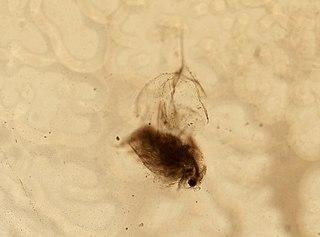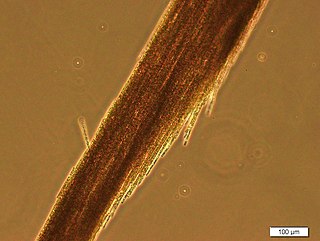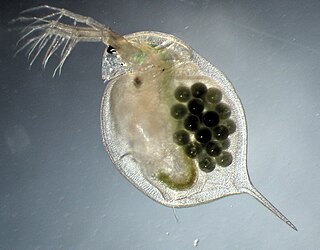
Plankton are the diverse collection of organisms found in water that are unable to propel themselves against a current. The individual organisms constituting plankton are called plankters. In the ocean, they provide a crucial source of food to many small and large aquatic organisms, such as bivalves, fish and whales.

Daphnia is a genus of small planktonic crustaceans, 0.2–5.0 mm (0.01–0.20 in) in length. Daphnia are members of the order Cladocera, and are one of the several small aquatic crustaceans commonly called water fleas because their saltatory (Wiktionary) swimming style resembles the movements of fleas. Daphnia spp. live in various aquatic environments ranging from acidic swamps to freshwater lakes and ponds.

Lake Kivu is one of the African Great Lakes. It lies on the border between the Democratic Republic of the Congo and Rwanda, and is in the Albertine Rift, the western branch of the East African Rift. Lake Kivu empties into the Ruzizi River, which flows southwards into Lake Tanganyika.

Meroplankton are a wide variety of aquatic organisms which have both planktonic and benthic stages in their life cycles. Much of the meroplankton consists of larval stages of larger organism. Meroplankton can be contrasted with holoplankton, which are planktonic organisms that stay in the pelagic zone as plankton throughout their entire life cycle.

Daphnia galeata is a small species of planktonic crustaceans. It lives in freshwater environments across a large area of the Northern Hemisphere, mostly in lakes.
Paratya curvirostris is a species of freshwater shrimp in the family Atyidae. It is endemic to New Zealand, where it is distributed from North Island to Stewart Island, and including the Chatham Islands. It is the only true decapod shrimp to inhabit freshwater in New Zealand.

Diel vertical migration (DVM), also known as diurnal vertical migration, is a pattern of movement used by some organisms, such as copepods, living in the ocean and in lakes. The migration occurs when organisms move up to the uppermost layer of the sea at night and return to the bottom of the daylight zone of the oceans or to the dense, bottom layer of lakes during the day. The word diel comes from the Latin dies day, and means a 24-hour period. In terms of biomass, it is the greatest migration in the world. It is not restricted to any one taxon as examples are known from crustaceans (copepods), molluscs (squid), and ray-finned fishes (trout). Various stimuli are responsible for this phenomenon, the most prominent being response to changes in light intensity, though evidence suggests that biological clocks are an underlying stimulus as well. The phenomenon may arise for a number of reasons, though it is most typically to access food and avoid predators. While this mass migration is generally nocturnal, with the animals ascending from the depths at nightfall and descending at sunrise, the timing can be altered in response to the different cues and stimuli that trigger it. Some unusual events impact vertical migration: DVM is absent during the midnight sun in Arctic regions and vertical migration can occur suddenly during a solar eclipse.

In aquatic biology, the paradox of the plankton describes the situation in which a limited range of resources supports an unexpectedly wide range of plankton species, apparently flouting the competitive exclusion principle which holds that when two species compete for the same resource, one will be driven to extinction.
Daphnia occidentalis is a species of crustacean in the family Daphniidae. It is endemic to Australia, and is the only species in the subgenus Australodaphnia.

Bythotrephes longimanus, or the spiny water flea, is a planktonic crustacean less than 15 millimetres (0.6 in) long. It is native to fresh waters of Northern Europe and Asia, but has been accidentally introduced and widely distributed in the Great Lakes area of North America since the 1980s. Bythotrephes is typified by a long abdominal spine with several barbs which protect it from predators.

Aphanizomenon is an important genus of cyanobacteria that inhabits freshwater lakes and can cause dense blooms. Studies on the species Aphanizomenon flos-aquae have shown that it can regulate buoyancy through light-induced changes in turgor pressure. It is also able to move by means of gliding, though the specific mechanism by which this is possible is not yet known.

Daphnia pulex is the most common species of water flea. It has a cosmopolitan distribution: the species is found throughout the Americas, Europe, and Australia. It is a model species, and was the first crustacean to have its genome sequenced.

Daphnia magna is a small planktonic crustacean that belongs to the subclass Phyllopoda. It inhabits a variety of freshwater environments, ranging from acidic swamps to rivers made of snow runoff, and is broadly distributed throughout the Northern Hemisphere and South Africa.

Leptodora is a genus containing two species of large, nearly transparent predatory water fleas. They grow up to 21 mm (0.83 in) long, with two large antennae used for swimming and a single compound eye. The legs are used to catch copepods that it comes into contact with by chance. Leptodora kindtii is found in temperate lakes across the Northern Hemisphere and is probably the only cladoceran ever described in a newspaper; L. richardi is only known from eastern Russia. For most of the year, Leptodora reproduces parthenogenetically, with males only appearing late in the season, to produce winter eggs which hatch the following spring. Leptodora is the only genus in its family, the Leptodoridae, and suborder, Haplopoda.
Daphnia lumholtzi is a species of small, invasive water fleas that originates in the tropical and subtropical lakes of Africa, Asia, and Australia. As an invasive species, Daphnia lumholtzi disrupts aquatic habitats by spreading throughout the warmer waters of lakes and reservoirs.

Daphnia is one of the three subgenera of the genus Daphnia, the others being Australodaphnia and Ctenodaphnia.

Daphnia longispina is a planktonic crustacean of the family Daphniidae, a cladoceran freshwater water flea. It is native to Eurasia. D. longispina is similar in size and sometimes confused with the often sympatric D. pulex, but much smaller than D. magna. D. longispina is found in a wide range of standing freshwater bodies from small, ephemeral rock-pools to large lakes.
John Langdon Brooks (1920-2000) was an American evolutionary biologist, ecologist and limnologist.

Daphnia pulicaria is a species of freshwater crustaceans found within the genus of Daphnia, which are often called "water fleas," and they are commonly used as model organisms for scientific research Like other species of Daphnia, they reproduce via cyclic parthenogenesis. D. pulicaria are filter-feeders with a diet primarily consisting of algae, including Ankistrodesmus falcatus, and they can be found in deep lakes located in temperate climates. Furthermore, D. pulicaria are ecologically important herbivorous zooplankton, which help control algal populations and are a source of food for some fish. D. pulicaria are closely related to Daphnia pulex, and numerous studies have investigated the nature and strength of this relationship because these species can produce Daphnia pulex-pulicaria hybrids. In recent years, D. pulicaria along with other Daphnia species have been negatively affected by invasive predators, such as Bythotrephes longimanus.












